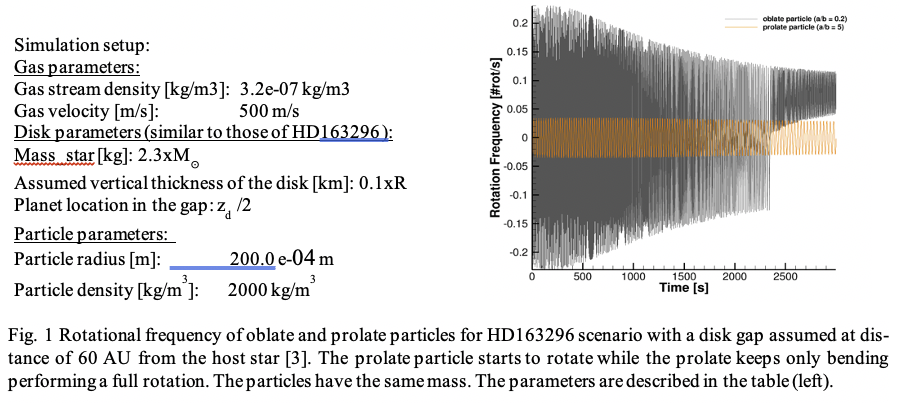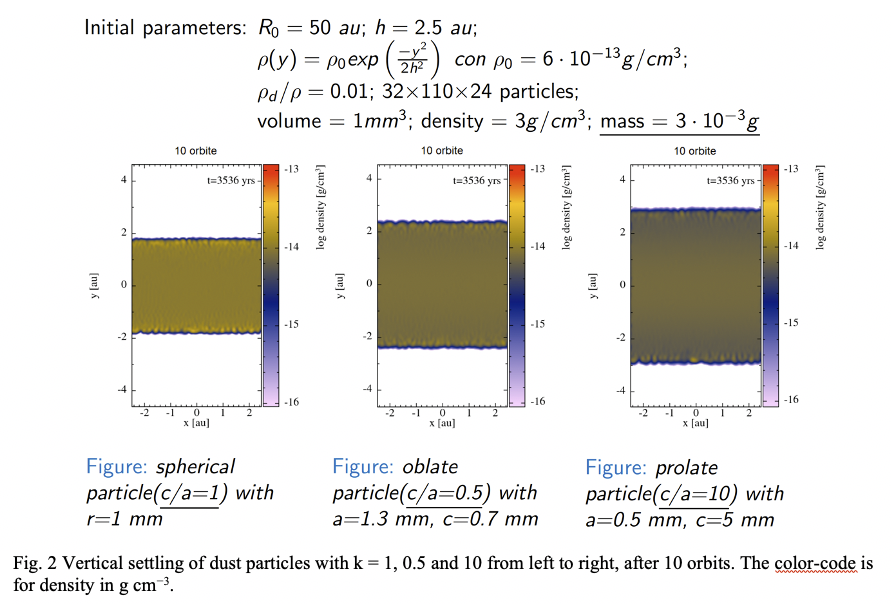Modelling Dust Dynamics in Protoplanetary Disks
- 1INAF - Osservatorio Astronomico di Trieste, Trieste, Italy (stavro.ivanovski@inaf.it)
- 2Università degli Studi di Trieste, Italy
- 3INAF - Osservatorio Astronomico di Torino, Italy
- 4INAF - Istituto di Astrofisica e Planetologia Spaziali, Roma, Italy
- 5INAF - Osservatorio Astronomico di Capodimonte, Italy
- 6INAF - Osservatorio Astronomico di Roma, Monte Porzio Catone (Roma), Italy
Introduction
Recent high-resolution ALMA observations of protoplanetary disks have raised interest in the study of solid bodies in disks at different scales, from sub-micrometric grains up to solid bodies hundreds of meters in size, for which dynamic evolution is governed by the interaction between the gas and the dust in the disk.
We propose a novel research in the field of dust evolution and dynamics in protoplanetary disks. One of the main goals of this research is to address the dust dynamics evolution, the dynamical interaction between proto-planetary bodies, preparing the path for the SKA Key Programmes. We aim at contributing to this field twofold: (i) modeling of non-spherical dust dynamics in rarefied gas field present in the disk gaps and (ii) to interpret and reconstruct protoplanetary disk observations through numerical simulations, extending the PHANTOM code [1] to non-spherical dust setup, i. e. a particular focus is how the dynamics is influenced by dust dimension and shape. One of the main objectives is to reproduce the image of ALMA data and understand how different disk initial dust parameters and dust characteristics may influence the disk evolution and face-on or edge-on appearance.
Using the state-of-the-art non-spherical dust dynamical model [2], developed for analysis of the ESA comet mission ROSETTA data, we determine the region in the gaps where the settling could occur as a function of the grain non-sphericity (shape, elongation), size, density etc. We investigate the terminal velocities and rotational frequencies of the non-spherical particles using different physical particle parameters, to show that the dust accommodation in the ring structures can be at distances different than what predicted by spherical dust models. The second focus of this work is to study the vertical settling with the SPH approach taking into account the dusty-gas interaction through the whole disk including possible planet-formation gaps.
Dust dynamics models
We use two models to simulate dust dynamics in protoplanetary disks: 1) a non-spherical dust dynamical model to simulate dust settling in Epstein regime and 2) the-state-of-the-art SPH code PHANTOM to simulate dust motion in both the Epstein and Stokes regimes.
The first code is a 3D+t non-spherical dust model that solves the Euler dynamical and kinetic equations. Considering free-collisional dust regime we study the effects on the particle dynamics provided with different particle shapes, initial orientation and velocities, as well as torque. Torque is computed from the law of variation of the angular momentum by using the Euler dynamic equations. The particles are assumed to be homogeneous, isothermal convex bodies. The dust motion is governed by the gas drag and gravity of the host star and/or a planet in the gaps.
The second model is a modified version of the PHANTOM code. We introduced non-spherical ellipsoidal particles and averaged drag coefficients for those non-spherical shapes. The code is a 3D+t SPH and MHD code and includes modules for self-gravity, dust-gas mixtures, viscosity, photo-evaporation, etc. A description of the parameters set used in these simulations with the results of simulations of dust settling are reported in Fig. 2. The plot is an example of dust settling in dusty disks, each of them having only one of three selected types of particles that are of the same mass and density, but of different shape.
Dust settling with non-spherical particles
Here we discuss two example cases produced by the two codes. Fig.1 shows rotational frequency (number of rotation per second) of two spheroids of different aspect ratio calculated with our non-spherical dust model in the Epstein regime. We simulate the dynamical properties and evolution of μm to mm sized particles in the case study with a planet in a disk gap at 60 AU, as observed in the HD163296 data [3, 4]. We assess the structure of the hypothesized vertically-extended dust layer. We investigated the influence of different dust sizes and initial dust speeds. Different spheroids of the same mass lead to different dynamics (e.g. velocity, angular velocity, etc) in the vertical settling phenomena.
In the second group of simulations our non-spherical dust setup of the PHANTOM code has been used. By utilizing the pre-calculated averaged drag coefficients of spheroid particles in Epstein regime we simulated dust vertical settling in a disk using the SPH approach. The non-spherical dust particles in Epstein regime settle down slower than their spherical equivalent particles (see Fig 2). Moreover, the settling of larger non-spherical dust particles in Stokes regime shows a stratified structure: a denser sub-disk near the mid-plane for dust in Stokes regime and suspended particles in Epstein regime.


Conclusions and future work
We used two different models to simulate non-spherical dust settling in protoplanetary disks. The first one computes dusty-gas motion in Epstein regime using free molecular expression for rarefied field [1]. The second one uses a newly implemented feature of the state-of-the-art PHANTOM code, namely non-spherical dust shapes. Both models reveal that the interpretation of the ALMA observations can be biased by the spherical particle approximation. In our future work we will describe what we found applying the two dust models with non-spherical particles to study the dust evolution of edge-on disks. Usually the mm-sized particles settling in protoplanetary disks are aggregates of fractals formed from the dusty-gas interactions during the protostellar nebula phase. Such aggregates could be approximated with compact porous particles if dynamical (e.g. drag coefficients) and physical (e.g. porosity, density, fractal dimension) parameters are taken into account.
Acknowledgments
This research was supported by the National Institute for Astrophysics, Italy (INAF) within the Mainstream project “Non-spherical dust dynamics in protoplanetary disks - how realistic dust particle shapes change the dust evolution timescales”.
References
[1] Price D. J. et al. (2018), PASA 35, E031
[2] Ivanovski S. et al. (2017), Icarus 282, p. 333 - 350.
[3] Isella et al. 2016, PRL, 117;
[4] ALMA Partnership et al. 2015, ApJ Lett. 808:L3,10pp;
How to cite: Ivanovski, S. L., Gerosa, F. A., Turrini, D., Capria, M. T., Alcala, J. M., Della Corte, V., Covino, E., Fulle, M., Vladilo, G., Silva, L., and Perna, D.: Modelling Dust Dynamics in Protoplanetary Disks, European Planetary Science Congress 2021, online, 13–24 Sep 2021, EPSC2021-809, https://doi.org/10.5194/epsc2021-809, 2021.

